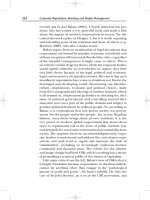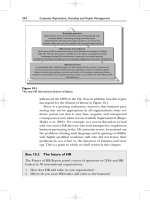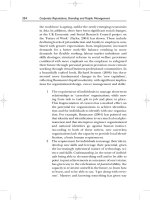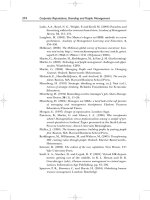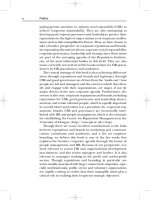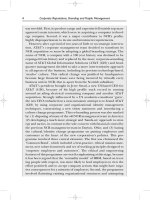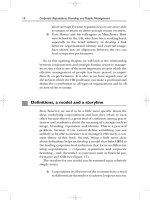Corporate Reputations, Branding and People Management 36
Bạn đang xem bản rút gọn của tài liệu. Xem và tải ngay bản đầy đủ của tài liệu tại đây (120.92 KB, 10 trang )
334 Corporate Reputations, Branding and People Management
■ The firm has explicit funding application criteria
■ Information is provided in the local language
■ The firm subscribes to the Global Reporting Initiative, a multi-
stakeholder process and independent institution that sets sustain-
ability reporting guidelines.
Based on published information on the internet, Jones has rated Diageo
as scoring the highest possible marks.
The conclusions of the authors are that Diageo’s efforts at corporate
citizenship have paid off in building ‘social capital’ inside and outside the
firm. Social capital refers to the levels of trust, socially responsible norms
of behaviour and social networks that are facilitated outside and inside an
organization through investment in social programmes. CC activities
have been especially positive in raising social capital with employees,
allowing them to make positive contributions to society while working in
an industry that presents some ethical concerns to people. The CC pro-
grammes have been very influential in recruiting talented graduates.
They also issue a word of warning, however, that:
subordinating corporate citizenship to commercial objectives reduces its
values to the company … There is an observable trend away from purely
charitable projects motivated by community need to projects that directly
serve the interests of Diageo’s brands. While this is understandable it is a
risky strategy as it undermines one of the major benefits of corporate
citizenship projects which is the building up of goodwill towards the
company based on altruistic involvement in the community. (p. 47)
Source: Based on Bek, Jones and Pollitt, 2005
References
Bakan, J. (2004) The corporation: the pathological pursuit of profit. New
York: Free Press.
Bebchuk, L. A. and Fried, J. M. (2006) Pay without performance:
overview of the issues. Academy of Management Perspectives, 20, 5–24.
Bek, D., Jones, I. W. and Pollitt, M. G. (2005) How do multinationals
build social capital? Diageo’s corporate citizenship programme,
Working paper No. 302, ESRC Centre for Business Research, March
2005. University of Cambridge.
CIPD (2002) Corporate social responsibility and HR’s role: a guide. London:
Chartered Institute of Personnel and Development.
CIPD (2005) Making CSR happen: the role of people management. London:
Chartered Institute of Personnel and Development.
Clarke, T. (ed.) (2004) Theories of corporate governance: the philosophical
foundations of corporate governance. London: Routledge.
Coffee, J. (2004) What caused Enron? A capsule of social and eco-
nomic history in the 1990s, in T. Clarke (ed.), Theories of corporate
governance: the philosophical foundations of corporate governance.
London: Routledge, pp. 333–358.
Cox, A. (2004) Win–win? The paradox of values and interests in business
relationships. Stratford-upon-Avon: Earlsgate Press.
Davenport, T. H. (2005) Thinking for a living: how to get better performance
and results from knowledge workers. Boston, MA: Harvard Business
School Press.
Diermeier, D. (2006) Leading in a world of competing values: a stra-
tegic perspective on corporate social responsibility, in T. Maak
and N. M. Pless (eds), Responsible leadership. London: Routledge,
pp. 155–169.
Economist (2005a) Another day, another probe, Economist, 17 December,
p. 35.
Economist (2005b) The greening of General Electric: a lean, clean
electric machine, Economist, 10 December, p. 79.
Economist (2005c) Local tastes: Pernod has ambitions for the global
drinks industry. Economist, 12 November, p. 86.
Elkington, J. ( 1997) Cannibals with forks: the triple bottom line of 21st cen-
tury business. Chichester: Capstone Publishing.
Florida, R. (2005) The flight of the creative class. New York: HarperCollins.
Fombrun, C. J. (2005) Building corporate reputation through CSR
initiatives: evolving standards, Corporate Reputation Review, 8 (1),
7–11.
Galbraith, J. (2002) Designing organizations: an executive guide to strategy,
structure and process (new and revised edn). San Francisco, CA:
Jossey-Bass.
Goldsmith, P. (2005) Attracting weapons grade talent to the general
insurance industry. Paper presented to the annual conference
of the Reputation Institute Annual Conference, Madrid, Spain,
19–22 May.
Goold, M. and Campbell, A. (2002) Designing effective organizations:
how to create structured networks. London: John Wiley.
Gordon, J. N. (2004) What Enron means in the management and con-
trol of the modern business corporation: some initial reflections,
in T. Clarke (ed.), Theories of corporate governance: the philosophical
foundations of corporate governance. London: Routledge, pp. 322–332.
Chapter 9 Corporate strategy, corporate leadership, corporate identity 335
Groysberg, B., Nanda, A. and Nohria, N. (2004) The risky business of
hiring stars, Harvard Business Review, 82 (May–June), 93–100.
Hagel III, J. and Seely-Brown, J. (2005) The only sustainable edge: why
business strategy depends on productive friction and dynamic special-
ization. Boston, MA: Harvard Business School Press.
Hamel, G. and Prahalad, C. K. (1996) Competing for the future: break-
through strategies for seizing control of your industry and creating the
markets of tomorrow. Boston, MA: Harvard Business School Press.
Joyce, W., Nohria, N. and Robertson, B. (2003) What really works: the
4+2 formula for sustained business success. Boston, MA: Harvard
Business School Press.
Kay, J. (1998) The role of business in society. Inaugural lecture, Said
School of Business, Oxford, 3 February. />society/133 (28 February 2006).
Kay, J. (2004) The truth about markets: why some nations are rich but most
remain poor. London: Penguin.
Kochan, T. and Lipsky, D. (eds) (2002) Negotiations and change: from
the workplace to society. Ithaca, NY: Cornell University Press.
Legge, K. (2004) Human resource management: rhetoric and realities
(Anniversary edition). London: Palgrave.
Mintzberg, H. (1987) Crafting strategy, Harvard Business Review, 65
(Jul–Aug), 66–75.
Mintzberg, H., Ahlstrand, B. and Lampel, J. (1998) Strategy safari.
Hemel Hempstead: Prentice Hall.
Monbiot, G. (2000) Captive state: the corporate takeover of Britain.
Basingstoke: Macmillan.
Norman, W. and MacDonald, C. (2004) Getting to the bottom of the
‘triple bottom line’, Business Ethics Quarterly, 14 (2), 243–262.
Pettigrew, A. M. and Whipp, R. (1991) Managing change for competitive
success. Oxford: Blackwell.
PriceWaterhouseCoopers (2002) Global CEO survey, January.
Roberts, J. (2004) The modern firm: organizational design for performance
and growth. New York: Oxford University Press.
Sternberg, E. (2000) Just business: business ethics in action (2nd edi-
tion). Oxford: Oxford University Press.
Sung, J. and Ashton, D. (2005) High performance work practices: linking
strategy and skills to work performance. London: Department of
Trade and Industry in association with the Chartered Institute
of Personnel and Development.
Wright, P., Dunford, B. B. and Snell, S. A. (2001) Contributions of the
resource-based view of the firm to strategic HRM: convergence
of two fields, Journal of Management, 27, 701–721.
336 Corporate Reputations, Branding and People Management
CHAPTER
The corporate agenda
and the HR function:
creating a
fit-for-purpose future
10
Introduction
At the end of the first chapter we raised the question of the sig-
nificance of the corporate agenda for the HR function. Given the
central theme of this book has been about the key role of people
management in creating difference through corporate reputa-
tions and brands and maintaining legitimacy through CSR and
good governance, we have sought to provide our HR readers with
a good grounding in these fields and some practical frameworks
and tools to help them contribute to these key strategic drivers
of organizational performance. However, the tensions between
corporate and local agendas – what we might call the universal
paradox in management – presents HR with difficult chal-
lenges but significant opportunities (see Box 10.1). These chal-
lenges and opportunities posed by reputation management and
338 Corporate Reputations, Branding and People Management
Box 10.1 Scottish & Newcastle, branding and people
management
Scottish & Newcastle (S&N) was the fourth largest European brewer in
2005 and in the top ten by sales volume in the world. It is a public com-
pany with a history dating back to 1749 and is listed on the London
Stock Exchange. Its headquarters are in Edinburgh, Scotland. S&N has
corporate branding, as well as the related issues of CSR and cor-
porate governance are, we believe, among the most important
the profession is likely to face, not least because they incorp-
orate most of the issues identified by some of the leading aca-
demic thinkers on the future of HR who also have an impact on
practice (Pfeffer, 1998; Sparrow et al., 2004; Huselid et al., 2005;
Ulrich and Brockbank, 2005).
So, in this chapter, we examine research and the speculation
about the changing role of HR, as well as current practice, to show
how HR professionals can contribute to the corporate agenda
more effectively. We also make some specific recommendations
for HR leadership in this field, especially on improving HR’s
professional competence in this field and credibility with the
other functions contributing to the corporate agenda, including
marketing, branding, CSR and senior leadership (see Figure 1.1
in Chapter 1). These recommendations should be timely in an
international context since there are a number of projects and
investigations looking at the future of HR in various countries,
including the CIPD, SHRM and the World Federation of
Personnel Management Associations. Hopefully our contribu-
tion will help them with their reflections.
To begin with, let’s look at a short case that deals directly with
the relationship between HR and branding. We will use it to
ground some of the ideas raised in the rest of this chapter.
The ‘think global and act local’
problem, HR and people
management
